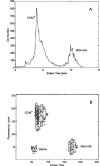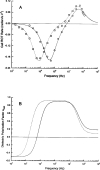The removal of human breast cancer cells from hematopoietic CD34+ stem cells by dielectrophoretic field-flow-fractionation
- PMID: 10791899
- PMCID: PMC2726259
- DOI: 10.1089/152581699319939
The removal of human breast cancer cells from hematopoietic CD34+ stem cells by dielectrophoretic field-flow-fractionation
Abstract
Dielectrophoretic field-flow-fractionation (DEP-FFF) was used to purge human breast cancer MDA-435 cells from hematopoietic CD34+ stem cells. An array of interdigitated microelectrodes lining the bottom surface of a thin chamber was used to generate dielectrophoretic forces that levitated the cell mixture in a fluid flow profile. CD34+ stem cells were levitated higher, were carried faster by the fluid flow, and exited the separation chamber earlier than the cancer cells. Using on-line flow cytometry, efficient separation of the cell mixture was observed in less than 12 min, and CD34+ stem cell fractions with a purity >99.2% were obtained. The method of DEP-FFF is potentially applicable to many biomedical cell separation problems, including microfluidic-scale diagnosis and preparative-scale purification of cell subpopulations.
Figures





Comment in
-
Ex vivo purging and cell expansion.J Hematother Stem Cell Res. 1999 Oct;8(5):457-8. doi: 10.1089/152581699319902. J Hematother Stem Cell Res. 1999. PMID: 10791896 No abstract available.
Similar articles
-
Cell separation by dielectrophoretic field-flow-fractionation.Anal Chem. 2000 Feb 15;72(4):832-9. doi: 10.1021/ac990922o. Anal Chem. 2000. PMID: 10701270 Free PMC article.
-
Cell separation on microfabricated electrodes using dielectrophoretic/gravitational field-flow fractionation.Anal Chem. 1999 Mar 1;71(5):911-8. doi: 10.1021/ac981250p. Anal Chem. 1999. PMID: 10079757
-
The efficiency of tumor cell purging using immunomagnetic CD34+ cell separation systems.Bone Marrow Transplant. 1997 Jun;19(12):1239-46. doi: 10.1038/sj.bmt.1700812. Bone Marrow Transplant. 1997. PMID: 9208119
-
Clinical applications of CD34+ cell-selected peripheral blood stem cells.Ther Apher Dial. 2003 Jun;7(3):298-304. doi: 10.1046/j.1526-0968.2003.00059.x. Ther Apher Dial. 2003. PMID: 12924604 Review.
-
Ex-vivo purging of hematopoietic progenitor cells.Curr Hematol Rep. 2004 Jul;3(4):257-64. Curr Hematol Rep. 2004. PMID: 15217555 Review.
Cited by
-
A dielectrophoresis-based microfluidic system having double-sided optimized 3D electrodes for label-free cancer cell separation with preserving cell viability.Sci Rep. 2022 Jul 15;12(1):12100. doi: 10.1038/s41598-022-16286-0. Sci Rep. 2022. PMID: 35840699 Free PMC article.
-
Rare Cell Capture in Microfluidic Devices.Chem Eng Sci. 2011 Apr 1;66(7):1508-1522. doi: 10.1016/j.ces.2010.09.012. Chem Eng Sci. 2011. PMID: 21532971 Free PMC article.
-
Stem cells in microfluidics.Biomicrofluidics. 2011 Mar 30;5(1):13401. doi: 10.1063/1.3528299. Biomicrofluidics. 2011. PMID: 21522491 Free PMC article.
-
Field-Flow Fractionation in Molecular Biology and Biotechnology.Molecules. 2023 Aug 23;28(17):6201. doi: 10.3390/molecules28176201. Molecules. 2023. PMID: 37687030 Free PMC article. Review.
-
Fluid-Screen as a real time dielectrophoretic method for universal microbial capture.Sci Rep. 2021 Nov 15;11(1):22222. doi: 10.1038/s41598-021-01600-z. Sci Rep. 2021. PMID: 34782647 Free PMC article.
References
-
- Gribben JG, Freedman AS, Neuberg D, Roy DC, Blake KW, Woo SD, Grossbard ML, Rabinowe SN, Coral F, et al. Immunologic purging of marrow assessed by PCR before autologous bone marrow transplantation for B-cell lymphoma. N Engl J Med. 1991;325:1525–1533. - PubMed
-
- Collins RH., Jr. CD34+ selected cells in clinical transplantation. Stem Cells. 1993;12:577–585. - PubMed
-
- Ross AA, Coope BW, Lazarus HM, et al. Detection and viability of tumor cells in peripheral blood stem cell collections from breast cancer patients using immunocytochemical and clonogenic assay techniques. Blood. 1993;82:2605–2610. - PubMed
-
- Rummel SA, VanZant G. Future paradigm for autologous bone marrow transplantation: tumor purging and ex vivo production of normal stem and progenitor cells. J Hematother. 1994;3:213–218. - PubMed
-
- Santos GW. The role of autologous hematopoietic stem cell transplantation in hematologic malignancy. Curr Opin Oncol. 1994;6:115–121. - PubMed
Publication types
MeSH terms
Grants and funding
LinkOut - more resources
Full Text Sources
Other Literature Sources
Medical
